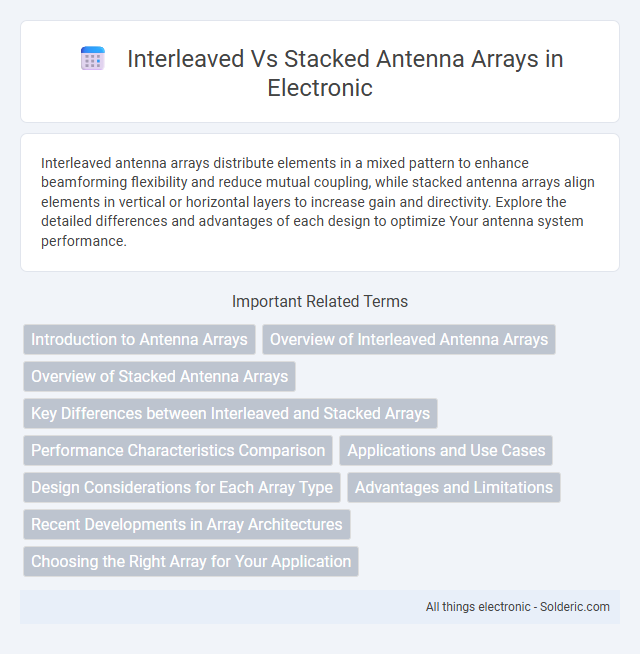Interleaved antenna arrays distribute elements in a mixed pattern to enhance beamforming flexibility and reduce mutual coupling, while stacked antenna arrays align elements in vertical or horizontal layers to increase gain and directivity. Explore the detailed differences and advantages of each design to optimize Your antenna system performance.
Comparison Table
| Feature | Interleaved Antenna Arrays | Stacked Antenna Arrays |
|---|---|---|
| Structure | Alternating elements from different arrays mixed in a single plane | Multiple antenna layers placed vertically, one above another |
| Beamforming | Enhanced spatial resolution with complex signal processing | Simple beam steering via phase shifting across layers |
| Size & Profile | Compact footprint, low profile | Taller structure, higher profile |
| Interference & Coupling | Higher mutual coupling due to element proximity | Reduced coupling from vertical separation |
| Application | High-resolution radar, MIMO systems | Base stations, satellite communications |
| Manufacturing Complexity | More complex layout and feeding network | More straightforward fabrication and assembly |
| Frequency Range | Commonly optimized for narrowband or specific bands | Supports broader frequency bands |
Introduction to Antenna Arrays
Antenna arrays consist of multiple radiating elements arranged systematically to improve signal directionality and gain. Interleaved antenna arrays position elements from different subarrays in an alternating pattern to enhance beamforming capabilities and reduce mutual coupling, while stacked arrays layer elements vertically to increase directivity and gain. Selecting between interleaved and stacked configurations depends on specific application requirements such as spatial constraints, frequency band, and desired radiation pattern.
Overview of Interleaved Antenna Arrays
Interleaved antenna arrays consist of multiple sub-arrays arranged so their elements alternate spatially, enhancing beamforming capabilities and reducing mutual coupling. This design improves angular resolution and side-lobe suppression by leveraging element diversity and spatial separation. Your communication system benefits from increased signal robustness and flexible beam steering achieved through interleaving techniques.
Overview of Stacked Antenna Arrays
Stacked antenna arrays consist of multiple antenna elements arranged in layers or tiers to improve gain and directivity by effectively increasing the aperture size. This configuration enhances signal strength and beam shaping capabilities, making it ideal for long-range communication and radar systems. Your application benefits from stacked arrays by achieving higher performance through improved radiation patterns and reduced sidelobes.
Key Differences between Interleaved and Stacked Arrays
Interleaved antenna arrays feature elements arranged in an alternating pattern to improve beam steering and reduce mutual coupling, while stacked arrays position elements directly above one another to enhance gain and directivity. Interleaved designs optimize spatial diversity and frequency reuse, whereas stacked arrays prioritize higher power output and simplified mechanical construction. Your choice depends on whether you need enhanced angular resolution or maximum signal strength for your application.
Performance Characteristics Comparison
Interleaved antenna arrays provide improved beam steering capabilities and reduced grating lobes compared to stacked arrays, enhancing signal clarity and range. Stacked arrays offer higher gain and simpler fabrication but may suffer from increased sidelobe levels and limited scanning angles. The choice between interleaved and stacked arrays depends on specific application requirements such as spatial resolution, frequency range, and array complexity.
Applications and Use Cases
Interleaved antenna arrays are commonly used in radar and communication systems requiring wide-angle scanning and enhanced beam steering capabilities, such as phased array radars in defense and aerospace. Stacked antenna arrays find applications in high-gain directional communication systems, including satellite ground stations and fixed wireless links, where power efficiency and narrow beamwidth are critical. Both types optimize spatial coverage and signal quality but are selected based on specific requirements like scan volume or gain.
Design Considerations for Each Array Type
Interleaved antenna arrays require careful consideration of element spacing and mutual coupling to minimize interference while maintaining broadband performance. Stacked antenna arrays emphasize alignment precision and mechanical stability to achieve high gain and directivity through vertical element arrangement. Both designs must balance trade-offs between array complexity, bandwidth, and radiation pattern control for optimal application-specific performance.
Advantages and Limitations
Interleaved antenna arrays offer improved spatial resolution and enhanced beamforming capabilities by combining multiple element types within a shared aperture, but they may suffer from increased design complexity and mutual coupling effects that degrade performance. Stacked antenna arrays simplify fabrication and reduce electromagnetic interference through separation of elements into distinct layers, though they often experience larger physical size and limited frequency agility. Understanding these trade-offs helps you select the optimal array configuration for applications requiring balanced performance, size, and frequency characteristics.
Recent Developments in Array Architectures
Recent developments in array architectures emphasize hybrid interleaved-stacked antenna arrays, combining the high gain and directivity advantages of stacked configurations with the wide bandwidth and improved scanning capabilities of interleaved designs. Advanced materials and 3D printing techniques enable seamless integration of diverse antenna elements within compact, multilayered structures, enhancing performance for 5G and beyond wireless systems. Machine learning algorithms optimize element placement and feed networks in these arrays, resulting in adaptive beamforming with reduced interference and higher spectral efficiency.
Choosing the Right Array for Your Application
Interleaved and stacked antenna arrays offer distinct advantages depending on your application requirements. Interleaved arrays provide improved beam steering and reduced sidelobe levels, ideal for applications needing precise directional control and frequency diversity. Stacked arrays deliver higher gain and broader coverage, making them suitable for long-range communication and wide-area monitoring.
interleaved vs stacked antenna arrays Infographic

 solderic.com
solderic.com